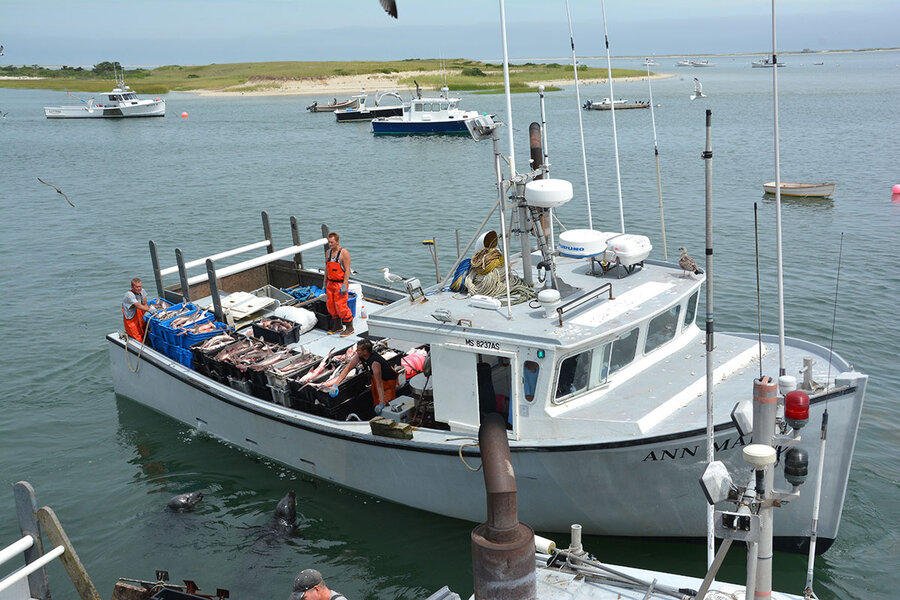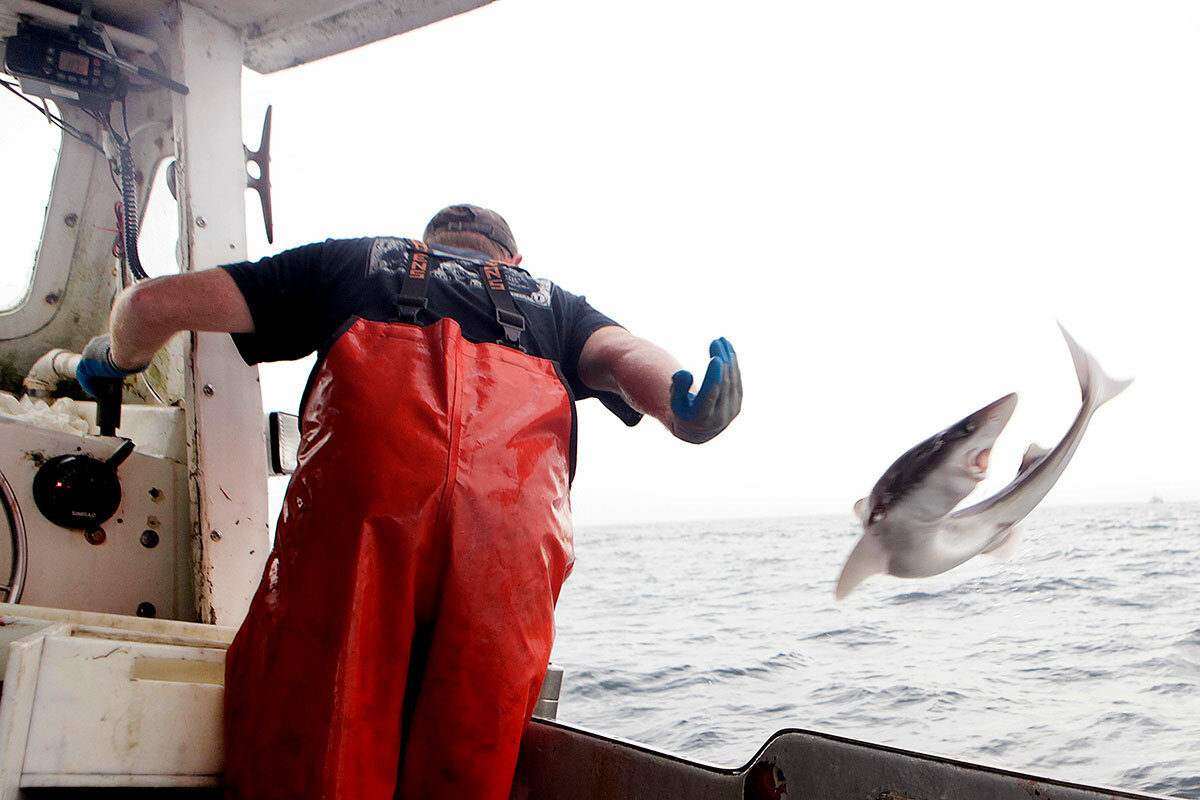Can dogfish save Cape Cod fisheries?
Loading...
| CHATHAM, MASS.
Low clouds hang over the pier as fishing boats line up to drop off their catch for the day. Fishermen in orange suspendered waders and rugged boots perch on the edges of their boats. The fishermen, with weathered faces and hands toughened by their work, ignore the tourists gawking and snapping photos from a viewing platform overhead.
Then, the fog descends, giving the scene a sense of timelessness. But this scene has changed from decades past. For 400 years, fishermen across Cape Cod caught boatloads of, well, cod. The fish was so plentiful and valuable that fishermen bought houses and new boats off cod profits alone. But today, there’s a different fish filling the piers: spiny dogfish.
Cape Cod has nearly lost its namesake fish, due to overfishing and climate change. So fishermen have switched to dogfish, skates, and other more plentiful options. This move could help revive the Massachusetts fishing industry, and might even help the cod rebound, researchers say. But getting Americans to bite may not be as easy.
Why We Wrote This
Overfishing and climate change are robbing Cape Cod of its namesake fish. Ever adaptable, fishermen are shifting sights to the dogfish. But Americans aren’t quite ready to bite just yet.
“This is the fish we could feed the United States with,” says Chatham fisherman Doug Feeney. “We have people that are hungry. We have prison systems. We have vets. We have homeless people. There’s just so much that can be done with this product.”
For a long time, fishermen saw dogfish as an annoyance. They were a “trash fish” with little value that often ended up clogging their nets. The large spines on their fins especially made them a pain to throw back, and they eat pretty much everything smaller than them – including juvenile codfish.
“They’re just a giant menace in the ocean,” Chatham fisherman Tim Linnell says. “You’ve got to get a lot of these out.”
Dogfish aren’t new to the area, but as cod populations have dwindled in recent decades, dogfish have flourished in their absence. So when cod could no longer pay the bills and became highly restricted to fish, fishermen turned to the thing that was already filling their nets.
“There’s no way around it,” says Mr. Feeney. “The dogs have taken over.”
A dog’s tale
Spiny dogfish are actually small sharks that reach just about 4 feet long. Thousands swim together in packs (like dogs), making them easy for fishermen to catch.
In the late 1980s and early 1990s, as the cod population crashed, dogfish seemed like a great option for Cape Cod fishermen. Dogfish practically jumped into their boats and were unregulated, so fishermen could catch as many as they could fit on their boats. But by the turn of the century, the dogfish population up and down the East Coast had plummeted. Regulators sharply curtailed dogfishing in 2000. Processors stopped working with dogfish.
Nearly a decade later, the population of dogfish had risen significantly again, and regulations have relaxed. The fishery is now certified sustainable by the Marine Stewardship Council, and commercial fishermen are allowed catch up to 6,000 pounds worth of dogfish on a given fishing trip – and they do. Sometimes they even have to throw some back when too many end up in their nets.
But the catch isn’t so sustainable for the fishermen themselves. Dogfish doesn’t pay the bills like cod once did. Cod can fetch dollars on the pound, while a pound of dogfish is typically worth around 25 cents.
So what would it take to make dogfishing economically sustainable for fishermen?
Mr. Linnell is among those who say the catch limit for each trip should be increased. “If you get 10,000 pounds with the current prices, you’re able to support your boat, your business,” he says. Others point out that with the current trip limits, fishermen along the East Coast bring in less than half of the total yearly quota for the entire coast.
But Feeney cautions that expanding trip limits may not be good for all fishermen. Small boat fishermen would start to go out of business with a 10,000 pound trip limit, he says, as their boats can’t carry that much. Instead, he says, the focus should be on increasing prices.
“It’s just the classic supply-demand situation where they don’t yet get paid much more per pound,” says Jen Levin, manager of the Sustainable Seafood Program at the Gulf of Maine Research Institute, who has done research on the marketability of dogfish in New England. “So it’s a long-term solution around building up markets, building up demand with a higher quality product. And it really is going to take a long time to do that before that price per pound goes up.”
Today the majority of dogfish is sent to Europe where it’s commonly used for fish and chips. About 2.6 million pounds of dogfish is currently exported from Massachusetts. Some, like Feeney, have been working to expand a market in Asia, too, offering a sustainable source of shark fins.
But there isn’t really a market in the US for dogfish. In fact, in Chatham, where 6 million pounds of dogfish are caught each year, this reporter called 15 restaurants looking for a place to try the local seafood and none had it on their menu.
Changing perceptions
There are a few projects pushing to build a market in the US for dogfish. Last year, as part of their “Pier to Plate” project, the Cape Cod Commercial Fishermen’s Alliance gave away more than 4,000 pounds of dogfish to local restaurants and events to promote locally caught fish. Separately, Feeney has worked with other fishermen to form the Chatham Harvesters Cooperative. They are working to cultivate a market for value-added products from dogfish like fish burgers, fish sticks, and breaded fish. Feeney and others are also marketing dogfish to universities and other large institutions with an eye toward volume.
The idea, says Steven Costas, a salesman for Marder Trawling Inc. in New Bedford, Mass., is to lay the groundwork. Once a market is established for dogfish as an inexpensive fish, demand will rise and so will price.
But it will take time, says Ms. Levin. For one thing, “the idea of replacing other seafood sales with dogfish is probably not as realistic,” she says. Diners accustomed to the light, flaky texture of cod, for instance, are likely to be disappointed by dogfish's firm and slightly oily meat. Dogfish needs its own place in the market.
“If we are able to grow overall seafood sales,” she adds, “then I think that there’s a lot of potential for dogfish.”
One challenge is the name. Dogfish is often thought of as a lower quality fish, or is unknown entirely. Some have toyed with the idea of renaming it “cape shark,” for example; foodservice distributor US Foods launched “Cape Shark Tenders” in 2017. In England, they call dogfish “rock salmon.”
But others say a name is just a name. “I think that the more people experience dogfish, the more they hear about it, the more they understand what it is, the more normal dogfish will be. We eat catfish. I don’t know why we wouldn’t eat dogfish,” says Levin. “Giving people those experiences is where we should focus our efforts.”
That’s the approach the University of Massachusetts Amherst is taking in using dogfish in the dining halls. Ken Toong, the executive director of auxiliary enterprises at UMass, was looking for more locally sourced seafood to feed students. Dogfish provided that opportunity, but he and his staff also discussed calling the fish something else, perhaps cape shark or something generic like whitefish. Ultimately, he says, they decided to just call it dogfish and use it as an opportunity to tell the story of the edible shark and where it came from. So far, Mr. Toong says, students have given dogfish good reviews.
Schools may be a good way to get Americans tasting dogfish. Chefs in dining halls can experiment with fish tacos, fish and chips, and even more creative cooking. And students are developing their habits for adulthood. Toong says: “I think we have lots of influence on our students’ dining habits now, and in the future.”
This story was produced with support from an Energy Foundation grant to cover the environment.







